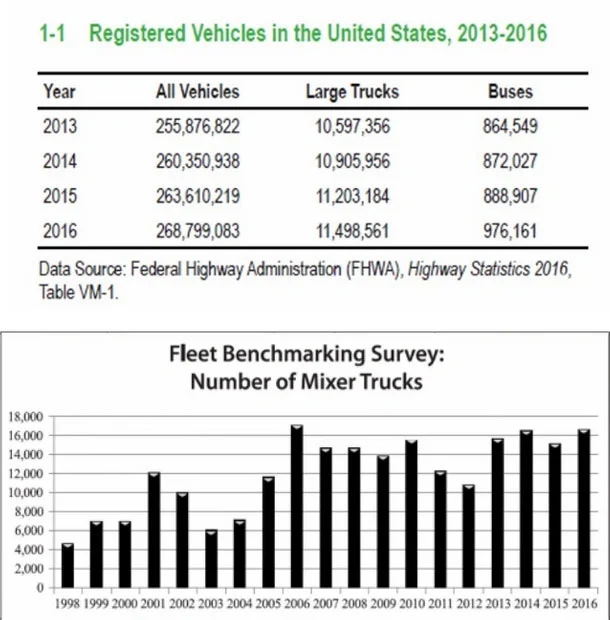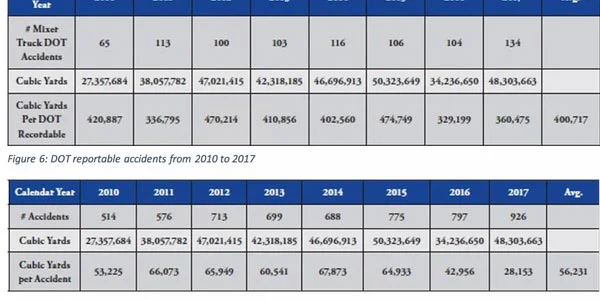Quick Facts
- A full concrete mixer truck weighs, on average, ten times the amount of a loaded pickup truck.
- Because mixer trucks carry most of their weight in their mixing drum, they are top-heavy, unstable, and have a rollover rate 10 times the average.
- Mixer trucks spend most of their time driving on city streets.
- Concrete mixers fall into the “Class 8 heavy truck” vehicle class, but because concrete mixers do not have a dedicated vehicle class, government reported data specific to mixer trucks is nonexistent.
- Based on crowdsourced data, there are an estimated 70,200 concrete mixer trucks on the road in the United States.
- Based on crowdsourced data, there are an estimated 794 annual Department of Transportation reportable accidents involving concrete mixer trucks, however, there are no data on the fatality of these accidents.
- According to government data about Class 8 heavy trucks, 4,102 people died in crashes involving Class 8 large trucks.
- 68 percent of people who died were occupants of cars and passenger vehicles and 14 percent were pedestrians and bicyclists.
- In two-vehicle crashes involving a large truck, 97 percent of the fatalities were those in passenger vehicles, only three percent were truck operators.
- YOU can help ensure that operators of these vehicles are held to high safety standards and held accountable. If you know of someone injured or killed by a concrete mixer truck, report it below.
Why Concrete Mixer Trucks Are Dangerous
It has been known for a long time that concrete and concrete mixers pose one of the largest risks in a construction operation[i], however, less known is how much of a danger concrete mixer trucks pose on the public streets of our cities. Concrete mixers are uniquely heavy. The average empty truck weighs 27,000 pounds and when filled with wet concrete, that increases to an average of 66,000 pounds[ii]. That is nearly ten times the weight of a fully loaded Ford F-150[iii]. Because most of their weight comes from the wet concrete in their mixing drum, these trucks carry most of their weight high relative to the road. A basic knowledge of physics will tell you that high weight leads to a high center of gravity which leads to an incredibly unstable vehicle. This is why concrete mixer trucks have a rollover rate of .5 percent,[iv] ten times the .05 percent average[v] [vi] [vii]. Mixer trucks also have three or four times the stopping distance of other vehicles [viii].
Unlike most other heavy trucks like an “18-wheeler” or “tractor-trailer,” concrete mixer trucks rarely drive on the highway. Why? Because once loaded on the truck, concrete has only 90 minutes before it must be poured and set at a construction site[ix]. This means that concrete mixers must be located near the construction site. Not only does this necessitate an astonishing fleet size, but it also means that anywhere there is a construction site (neighborhoods, suburbs, industrial areas, major urban centers) there will be concrete mixers on the road.
- [i] https://www.osha.gov/Publications/concrete_manufacturing.html
- [ii] https://www.structuremag.org/?p=10927
- [iii] https://www.caranddriver.com/ford/f-150/specs
- [iv] https://www.nrmca.org/operations/Documents/2014FleetSurveyFinalReport.pdf
- [v] https://www.safercar.gov/Vehicle-Shoppers/Rollover/Fatalities#:~:text=Rollover%20Characteristics&text=Rollovers%20are%20dangerous%20incidents%20and,deaths%20from%20passenger%20vehicle%20crashes.
- [vi] https://www.driverknowledge.com/car-accident-statistics/
- [vii] https://www.statista.com/statistics/183505/number-of-vehicles-in-the-united-states-since- 1990/#:~:text=How%20many%20registered%20motor%20vehicles,at%206.3%20million%20in%202016.
- [viii] https://www.kansascityaccidentinjuryattorneys.com/library/cement-trucks-may-not-be-able-to-brake-before-an-accident.cfm
- [ix] https://www.tristar-concrete.com/how-long-can-you-wait-to-pour-concrete-from-ready-mix-trucks

Do They Cause A Lot of Accidents?
The short answer is, we don’t know for sure. And that is the problem. When an accident is reported by authorities, so is basic vehicle identification information. Generally, this means the make and model of a vehicle (e.g. Chevrolet Silverado) and the vehicle’s classification. Concrete mixer trucks are classified as “Class 8 Heavy Trucks”, but so are “18- wheelers” and “tractor-trailers.[i]” So while there are government databases for vehicle accidents, it is impossible to determine which accidents involve concrete mixers specifically. Even searching by make and model is useless because many concrete truck makes and models, e.g. the MACK Granite, are also configurable to a dump truck or a trash truck. So again, it is impossible to determine which accidents involve concrete mixers. There is not even a public database that tells us how many of these vehicles operate in the United States.
For a vehicle that saturates our cities and even our neighborhoods, we need information and data as to its safety. Luckily, by crowdsourcing data, the National Ready Mixed Concrete Association (NRMCA)[i] releases information estimating just how dangerous these trucks are.

How Many Concrete Mixer Trucks are There in the United States?
Again, because national commercial vehicle registries do not have a specific classification for mixer trucks, there are no government-produced data for the exact number of mixer trucks that are operational in the United States. DOT publishes general statistics in its “Pocket Guide to Large Bus and Truck Statistics[i]. (Figure 2) mixing trucks fall into the “Large Trucks” category, but so do many other trucks.
In their 2017[1] annual Fleet Benchmarking and Cost Survey[i], the NRMCA published an estimate for the total number of mixer trucks on the road. They did this by surveying 82 mixer truck operators, asking questions regarding fleet size, chassis type, etc. They reported that those eighty-two companies cumulatively had a fleet size of “16,604 concrete mixer trucks.” They found that each truck’s average annual load was “4,889” cubic yards of concrete. Using that information in conjunction with their estimate for the total yards of concrete poured in the United States, “(approx. 343 million cubic yards)”, they “estimate the number of ready mixed concrete trucks currently operating in the United States to be approximately 70,200.”
- [1] There is no reason to suggest the NRMCA discontinued their annual publishing of this report, however the reports for 2018 and 2019 appear to not exist in electronic form.
- [i] Kauzlick, Tim et. al. National Ready Mixed Concrete Association, 2017, pp. 18–25, Concrete In Focus Magazine.
- [i] https://www.fmcsa.dot.gov/safety/data-and-statistics/commercial-motor-vehicle-facts Say something interesting about your business here.

How Many are Involved in Accidents?
This too is a complicated question for the reasons stated above. Government transportation regulatory agencies do not maintain data specific to concrete mixer trucks. Once again, we are forced to turn to crowdsourced data and approximations.
The NRMCA compiles accident report data in their “Safety Benchmarking Survey Report.[i]” Like the Fleet Benchmarking survey, this gives information compiled from 43 operators across the country in the hopes that those 43 operators are representative of the industry as a whole. NRMCA adds a disclaimer saying “The report is based on information contained in the OSHA 300A summary log of member companies that responded to the information request. The reliability of the data is only as accurate as those compiling the individual OSHA 300A logs, thus users of this report must keep this in mind.”
The report compiles two different sets of information. First are DOT recordable accidents which are defined as “an occurrence involving a commercial motor vehicle on a public road in intrastate or interstate commerce, which results in: 1) a fatality; 2) injury to a person requiring immediate treatment away from the scene of the accident; or 3) disabling damage to a vehicle, requiring it to be towed.” The second type of accident is described as “Number of vehicle accidents with damage to company vehicle or civilian vehicle.” These are often accidents occurring on private construction sites, or with minimal damage and are not DOT reportable. NRMCA then normalizes this data by dividing the total number of annual cubic yards the 43 respondents produced, by their annual accidents. This outputs a rate of cubic yards poured per accident. The two data tables found in this 2017 Safety Benchmarking Survey are below.
Given that this report surveyed only 43 operators, this is not the total number of incidents, however, if one divides the total estimated concrete poured in the United States in 2017 (from above) by the rate of cubic yards per accident, the output will be the total cumulative DOT reportable accidents. 343,000,000 (yd.3 in 2017) / 360,475 (yd3 / accident in 2017) = 952 DOT reportable accidents for concrete mixer trucks. The same process could be followed and yield 12,183 non-reportable accidents. Averaging available NRMCA data from 2014[ii], 2015[iii], and 2017, yields 794 annual concrete-mixer-truck-involved, DOT-reportable incidents.
- [i] Williams, David et. al. National Ready Mixed Concrete Association, 2017, pp. 22–29, Concrete In Focus Magazine.
- [ii] Hinkle, Jeff et. al. National Ready Mixed Concrete Association, 2014, Concrete In Focus Magazine.
- [iii] Hinkle, Jeff et. al. National Ready Mixed Concrete Association, 2015, Concrete In Focus Magazine.

Rollover Data
Due to their high center of gravity and extreme instability, concrete mixer trucks are at extremely high risk of rolling over. So much so that in 2017, the NRMCA conducted a special report[i] on the subject. The data was collected using the same survey method used in the other reports referenced. They received 61 responses. As is demonstrated in figures 7-9, rollovers occur almost always when the truck is full, when it is driving on flat, dry, asphalt, and occurs most often on rural roads. NRMCA explains this saying, “Surprisingly, only one rollover occurred on a concrete road, but even more puzzling was that the majority of the rollovers happened on dry and level pavement. One can conclude that this is more evidence of ‘loss of driver focus on the task at hand’ as a major reason for mixer truck rollovers.” Also, 15 percent of rollovers occur on a city street.
- [i] Williams, David et. al. National Ready Mixed Concrete Association, 2018, Concrete In Focus Magazine.
How Many People are Hurt or Killed in These Accidents?
You might notice a common theme here, but we don’t know for sure and crowdsourced data from industry advocates such as the NRMCA is silent on this matter. However, we do have data on Class 8 heavy trucks, and they are chilling. According to the Federal Motor Carrier Safety Administration (FMCSA), in 2017, 4,102 people died in crashes involving Class 8 large trucks. 68% of people who died were occupants of cars and passenger vehicles and 14 percent were pedestrians and bicyclists. In two-vehicle crashes involving a large truck, 97 percent of the fatalities were those in passenger vehicles, only 3 percent were truck operators.[i] While alarming, these data are unsurprising. Even at low speeds, a large passenger pickup truck like the F-150 stands no chance against a vehicle nearly ten times its weight.
- [i] Data accessed via https://battafulkerson.com/cement-truck-accidents/
What Can You Do?
The bottom line is this: we know concrete mixer trucks are involved in traffic accidents and we know when this happens, there is a high probability people are injured or killed. So, public oversight and accountability on the part of individual mixer truck operators is essential for the safe operation of these dangerous vehicles in your city and on the streets of your neighborhood.
If you know of somebody who has been injured or killed in a concrete mixer truck incident, please report it below. Together, we can ensure that operators of these vehicles are held accountable and that they use these important, yet dangerous tools safely and effectively.


